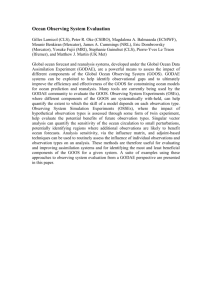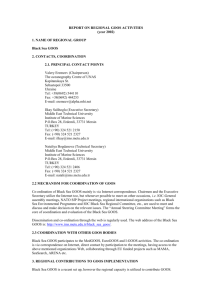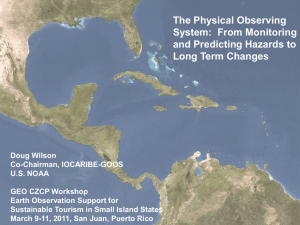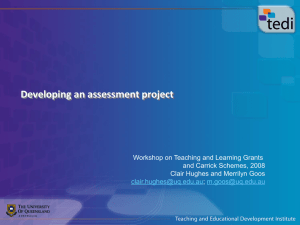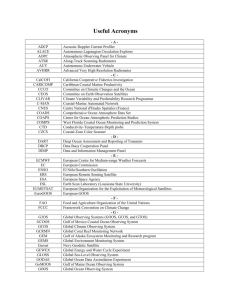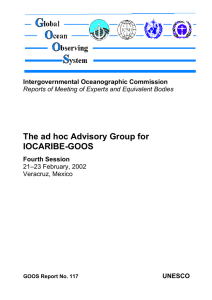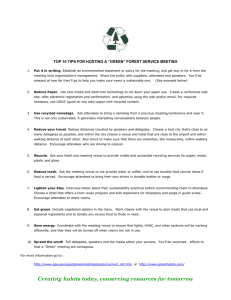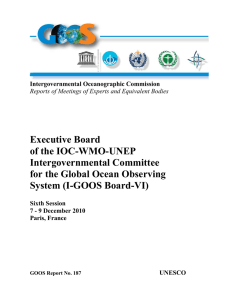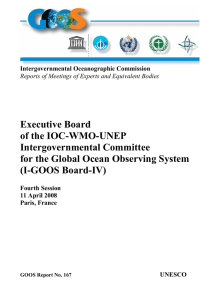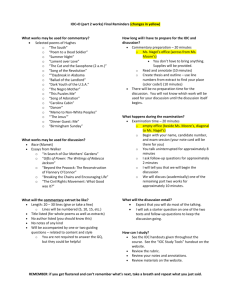Regional Forum of the Global Ocean Observing System (GOOS) Intergovernmental Oceanographic Commission
advertisement
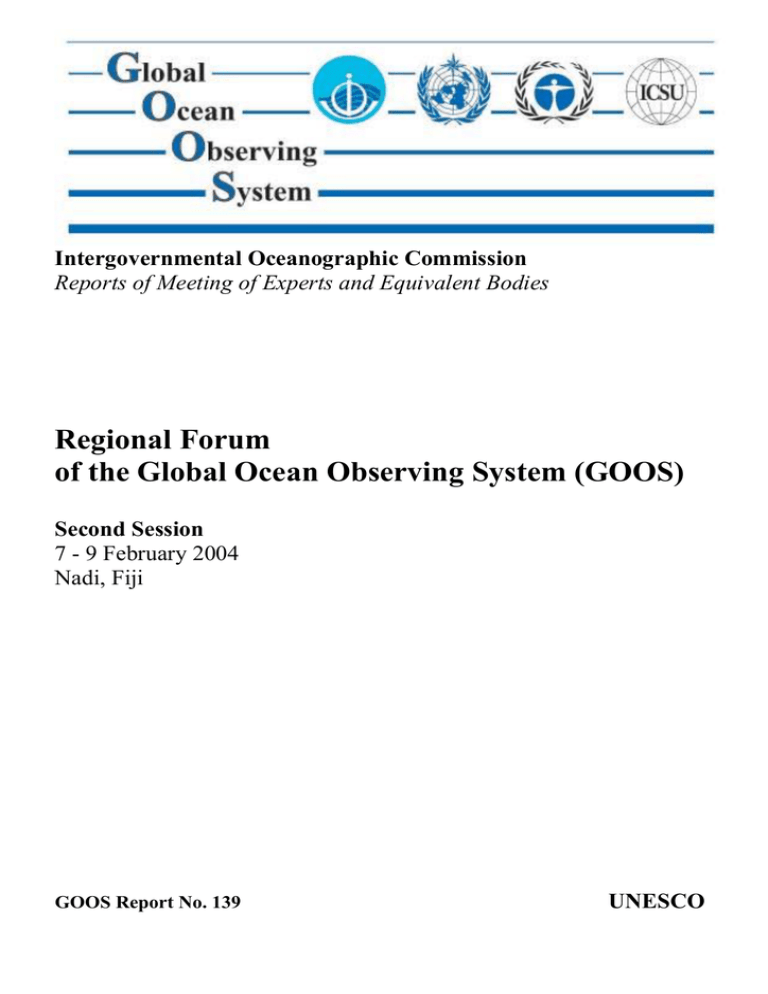
Intergovernmental Oceanographic Commission Reports of Meeting of Experts and Equivalent Bodies Regional Forum of the Global Ocean Observing System (GOOS) Second Session 7 - 9 February 2004 Nadi, Fiji GOOS Report No. 139 UNESCO Intergovernmental Oceanographic Commission Reports of Meeting of Experts and Equivalent Bodies Regional Forum of the Global Ocean Observing System (GOOS) Second Session 7 - 9 February 2004 Nadi, Fiji GOOS Report No. 139 UNESCO 2004 GOOS-RF-II/3 Paris, April 2004 Original: English∗ ABSTRACT (TO BE INSERTED ULTERIORLY) ∗ Translated into French and Spanish GOOS–RF–II page (i) TABLE OF CONTENTS SUMMARY Page 1. 1.1 1.2 1.3 OPENING AND WELCOME ..............................................................................................................1 WELCOME AND INTRODUCTIONS ..................................................................................................1 DOCUMENTS AND AGENDA .............................................................................................................1 LOGISTICS .............................................................................................................................................1 2. THE FUTURE OF THE REGIOANL GOOS FORUM ....................................................................1 3. ADVANCES IN PLANNING FOR COASTAL GOOS ....................................................................2 4. 4.1 4.2 4.3 4.4 KICK-OFF MEETING FOR GOOS REGIONAL ALLIANCE NETWORK DEVELOPMENT (GRAND) ................................................................................................................................................2 GRAND WORKPACKAGE 1 – INFORMATION ................................................................................2 GRAND WORKPACKAGE 2 – EMPOWERMENT.............................................................................3 GRAND WORKPACKAGE 3 – STRATEGY .......................................................................................3 THE CONTRACTUAL OBLIGATIONS ...............................................................................................3 5. GENERAL DISCUSSION ....................................................................................................................3 6. 6.1 6.2 6.3 6.4 CAPACITY BUILDING FOR THE GRAs .........................................................................................4 PLANS FOR GOOS AND JCOMM CAPACITY BUILDING ..............................................................4 JAPANESE CAPACITY BUILDING PROGRAMME IN THE PACIFIC ISLANDS REGION..........4 PLANS FOR ARGO IN THE PACIFIC ISLANDS ...............................................................................5 THE SEREAD PROGRAMME ..............................................................................................................5 7. 7.1 7.2 SUCCESS STORIES AND NEEDS OF GRAs ...................................................................................6 REPORTS ON THE PROGRESS AND PLANS OF THE GRAs ..........................................................6 DISCUSSION ON GRA DEVELOPMENTS.........................................................................................6 8. THE FUTURE OF THE GOOS REGIONAL FORUM ...................................................................7 9. FUTURE MEETINGS ..........................................................................................................................7 10. CLOSE....................................................................................................................................................7 11. LIST OF ACTIONS...............................................................................................................................6 ANNEXES I. PROVISIONAL AGENDA II. LIST OF PARTICIPANTS III. LIST OF DOCUMENTS IV. THE DECLARATION ON A GOOS REGIONAL COUNCIL (GRC) GOOS–RF–II page (ii) ADDITIONAL INFORMATION AVAILABLE ON THE GOOS WEB SITE: REGIONAL REPORTS are tabled separately on the GOOS web site at http://ioc.unesco.org/goos/grf2/GRF2_doclst.htm 1. EUROGOOS 2. MEDGOOS 3. BLACK SEA GOOS 4. GOOS-AFRICA 5. INDIAN OCEAN GOOS 6. PACIFIC ISLANDS GOOS 7. NEAR-GOOS 8. SEA-GOOS 9. IOCARIBE-GOOS 10. US GOOS 11. WAGOOS 12. GRASP 13. SOUTH ATLANTIC GOOS ACTIVITIES 14. PROPOSED CASPIAN SEA GOOS POWERPOINT PRESENTATIONS BY PARTICIPANTS are also tabled separately on the GOOS web site at: http://ioc.unesco.org/goos/grf2/GRF2_presentations.htm A. Silvana Vallerga: Future of the GOOS Regional Alliances and Regional GOOS Forum B. Julie Hall: Coastal GOOS and GOOS Regional Alliances C. Aldo Drago: GRAND Work Package_1 D. Silvana Vallerga: GRAND Work Package_2 E. John Woods: GRAND Work Package_3 F. Aldo Drago: GRAND Contract Obligations G. Geoff Brundrit: Capacity Building H. Kazu Kitazawa: Japanese Capacity Building Programme in the Pacific I. Stan Wilson and Howard Diamond: Argo and GCOS in the Pacific J. Julie Hall: the SEREAD programme K. Hans Dahlin: EuroGOOS L. Aldo Drago: MedGOOS M. Gannady Korotaev: Black Sea GOOS N. Justin Ahanhanzo: GOOS-AFRICA O. Srinivas Kumar: Indian Ocean GOOS P. Cristelle Pratt: Pacific Islands GOOS Q. Robert Smith: Cook Islands Pilot Project R. Vyackeslav Lobanov: NEAR-GOOS GOOS–RF–II page (iii) S. Miguel Fortes: SEA-GOOS T. Doug Wilson: IOCARIBE-GOOS U. Dave Martin: US-GOOS V. Ray Steedman: WAGOOS W. Rodrigo Nunez: GRASP X. Janice Trotte: South Atlantic GOOS GOOS–RF–II 1. OPENING AND WELCOME The second session of the Regional GOOS Forum took place in the Tanoa International Hotel, Nadi, Fiji. The session was opened at 09.00 on Saturday 7 February 2004 by the chairperson of the Intergovernmental Committee for GOOS (I-GOOS), Mme Silvana Vallerga, who was the chairperson for the session. 1.1 WELCOME AND INTRODUCTIONS Mme Vallerga welcomed participants to the session. Mr Alf Simpson, who is Chair of Pacific Islands GOOS, and was formerly the Director of the South Pacific Applied Geosciences Commission (SOPAC), welcomed participants to Fiji. His welcome was seconded by the new Director of SOPAC, Ms Cristelle Pratt, who reminded participants that the ocean was the main connector of the Pacific islands, and provided them with most of their resources. She explained that in recognition of this basic fact SOPAC and partners had completed during the preceding week a major Pacific Forum to address the key ocean issues for the region and to address the issue of ocean governance. Mr Simpson then introduced visiting observers from the SOPAC region. Mr Colin Summerhayes, Director of the GOOS Project Office (GPO), welcomed participants on behalf of the IOC. 1.2 DOCUMENTS AND AGENDA Colin Summerhayes explained the plan of the meeting as set out in the revised provisional agenda (Annex I), and noted minor changes due to the fact that some speakers had become unavailable. The participant’s list (Annex II) was circulated for possible amendments. Mr Summerhayes introduced the list of working documents for the meeting (Annex III). Many of these had been made available before the meeting, through the GOOS web site (http://ioc.unesco.org/goos). He reminded participants that to stimulate the interchange of ideas, each GRA had been asked to provide details about itself and its activities on a standard form (the “Regional Template”). Completed Regional Templates had been made available before the meeting for most of the regions and were tabled at the meeting for Pacific Islands GOOS, IOCARIBE-GOOS and the southwest Atlantic; reports were still outstanding at the time of the meeting for EuroGOOS and US GOOS. All of the regional reports are available on the GOOS web site at: http://ioc.unesco.org/goos/grf2/GRF2_doclst.htm Power-point presentations made during the meeting are also available on the GOOS web site at: http://ioc.unesco.org/goos/grf2/GRF2_presentations.htm 1.3 LOGISTICS Ms Pratt introduced the local organizing committee, explained the local arrangements, and announced that all of the power point presentations would be made available on a CD for each participant after the meeting. 2. THE FUTURE OF THE REGIONAL GOOS FORUM Silvana Vallerga’s presentation is outlined in the power-point slides given in Presentation A (http://ioc.unesco.org/goos/grf2/presentations/Forum_A.ppt). In it she explained the background to the development of the Forum, and listed its objectives: (i) to bring all the regional groups together regularly so as to benefit from each other's achievements; (ii) to promulgate “best practice”; (iii) to create a sense of community between the GRAs; and (iv) to ensure an harmonious development of GOOS at the global level. The achievements of GRAs are impressive and their coverage of the planet’s seas and oceans is almost completed. The Forum offered an opportunity to establish benchmarks by sharing experience, assessing progress, and identifying gaps. Common activities should now be planned. GOOS–RF–II page 2 Dr Vallerga presented the shared vision for GRAs, through which they could work together to improve local marine environment services in every region by exploiting the Global Ocean Observing System. A strategy for linking the global and coastal components of GOOS for the benefit of the regions should be articulated by the regions, building on the achievements of the OOPC and COOP panels. Each region has different problems, and each can exploit differently the potential offered by GOOS. Capacity has to be built and additional resources found. Dr Vallerga proposed that to enable the GRAs to make a convincing case for investment in GOOS, and to make collectives decisions, the chairs of GRAs should work together through a GOOS Regional Council (GRC). The mission of the GRC should be to build a coherent strategy for improving local marine environmental services by exploiting the Global Ocean Observing System. The members of the GRC should be the chairpersons of the GRAs. The GRC could meet back to back with the meetings in which the GRAs are participating, such as sessions of the GOOS Regional Forum, and of I-GOOS, and in conjunction with workshops of the GRAND project, funded by the European Commission. The participants were supportive of the proposal for a Regional Council, but noted that the terms of reference and modus operandi would need to be elaborated, as would its relationships to existing GOOS structures. This topic is discussed further under agenda item 9, below. 3. ADVANCES IN PLANNING FOR COASTAL GOOS Julie Hall, or the Coastal Ocean Observations Panel (COOP), described progress with and plans for the continued development of Coastal GOOS (Presentation B : http://ioc.unesco.org/goos/grf2/presentations/Forum_B.ppt). She drew attention to the proposal to create a Global Core Network (GCN) Technical Group. It is the task of the Group to work with the GRAs to help them to make GOOS happen following common standards and approaches. The Group is not meant to be atop down structure, but a facility for GRAs (and national GOOS bodies) to use. Partnership is the key word. A question was raised about the management role of COOP in relation to the management roles of JCOMM and the GRAs. The Director GPO made it clear that COOP is an advisory body, not a management body. The Global Core Network (GCN) Technical Group being proposed by COOP (Presentation B) will provide technical advice to management bodies. It was also made clear that the role and existence of COOP would have to be examined when it had produced its implementation plan at the end of 2004. COOP currently provides advice to JCOMM, and it is likely that JCOMM will need some body such as the GCN Technical Group to continue to provide coastal GOOS advise it in future. Participants agreed that to encourage data exchange there was a need to demonstrate the benefits of sharing high-resolution, real-time data. Participants agreed there was a need not only for COOP plans to be exposed to the GRAs, but also for COOP to provide technical advice to the GRAs on their own plans for coastal GOOS pilot projects. Action: COOP to be asked to consider developing a mechanism through which it could advise GRAs on their science plans for regional coastal GOOS pilot projects. 4. KICK-OFF MEETING FOR GOOS REGIONAL ALLIANCE NETWORK DEVELOPMENT (GRAND) 4.1 GRAND WORKPACKAGE 1 – INFORMATION Aldo Drago, Technical Secretary of MedGOOS, gave some of the background to GRAND and described work package 1 (Presentation C: http://ioc.unesco.org/goos/grf2/presentations/Forum_C.ppt). GOOS–RF–II page 3 4.2 GRAND WORKPACKAGE 2 - EMPOWERMENT Silvana Vallerga described work package 2 (Presentation D: http://ioc.unesco.org/goos/grf2/presentations/Forum_D.ppt). In discussion, Peter Pissierssens reminded participants of the potential offered by the IOC’s Ocean Teacher programme for education and training in operational oceanography. This tool has been developed in support of ocean data and information management, but can be used for any oceanographic topic. 4.3 GRAND WORKPACKAGE 3 - STRATEGY Professor John Woods, Imperial College London, provided some ideas of how work package 3 might be approached, especially noting the potential provided by the Virtual Ecology Workstation (VEW) (Presentation E in http://ioc.unesco.org/goos/grf2/presentations/Forum_E.ppt). 4.4 THE CONTRACTUAL OBLIGATIONS On behalf of Alan Edwards, of the European Commission, Aldo Drago described the contractual obligations for GRAND partners (Presentation F in http://ioc.unesco.org/goos/grf2/presentations/Forum_F.ppt). 5. GENERAL DISCUSSION A general discussion on agenda items 3 and 4 (above) was chaired by John Woods, and Aldo Drago. Participants agreed that GRAND was a good development. It was agreed that the managers of GRAND must ensure that their activities (i) are strongly linked to, rather than independent of, other ongoing GOOS activities; and (ii) complement what the GRAs are already doing. Participants also noted that the there are significant national operational oceanography activities that are outside the remit of the GRAs. Participants noted that GOOS developments, including those of the GRAs, were ideally placed to contribute to and take advantage of the outcomes of the ongoing development by the Group on Earth Observations (GEO) of a ten-year plan for global observations, as discussed under agenda item 8.1 below. This process is giving the need for global observations a high and unprecedented profile within governments. In taking GRAND and the GRAs forward, participants agreed that maximum use must be made of the existing capacity building efforts of GOOS, the IOC, the WMO, and their partners. Every effort must also be made to exploit new developments taking place to develop the regional Large Marine Ecosystem programmes that are being funded around the world by the Global Environmental Facility (GEF) of the World Bank, and the new developments of UNEP’s reinvigorated Regional Seas Programme. As yet, few of the LME projects or the RSP projects are strong. The LMEs, RSPs and GRAs would all benefit from the development of COOP’s Global Core Network Technical Advisory Group. There was general concern about the possibility that difficulties in data exchange between neighbouring nations could hamper the regional development of GOOS. Some participants questioned the need for the development of a global coastal GOOS. Nevertheless, all agreed that the collection of common data to common standards can help coastal managers assess the ways in which their local systems are similar to or differ from those of other areas, and draw lessons from such comparisons. GLOSS (the global sea level observing system, which is an integral part of both GOOS and JCOMM, was cited as one global coastal measuring system where there was a self-evident value to collecting particular kinds of coastal data (in that case sea level) globally. Although there have been some difficulties with funding and operating GLOSS stations in some parts of the world, a recent spate of proposal writing is leading to the allocation of new funding streams to improve the performance of the weaker elements of GLOSS. Janice Trotte noted that part of the problem in maintaining GLOSS is not technology, but the shortage of manpower to process the high volumes of data arising from tide gauges, and to feed that processed data into the GLOSS sea-level centres. Stan Wilson noted that, even with adequate funding and the availability of skilled manpower, the timely provision of hourly observations of sea level from certain GLOSS sea level stations is hindered by the perceived threat to national security. GOOS–RF–II page 4 The discussion on funding continued when Ray Steedman indicated that funding of GOOS programs particularly in the developing regions of the Indian Ocean is difficult. He suggested that IGOOS and the GRA's should consider improving the mechanism to identify and develop funding streams for GOOS activities. 6. CAPACITY BUILDING FOR THE GRAS 6.1 PLANS FOR GOOS AND JCOMM CAPACITY BUILDING Geoff Brundrit, Chair of the GOOS Capacity Building (CB) Panel set out progress and plans in capacity building for GOOS and JCOMM, including making the case for the merger that had been proposed between the GOOS CB Panel and the JCOMM CB Coordinating Group (Presentation G in http://ioc.unesco.org/goos/grf2/presentations/Forum_G.ppt). Peter Pissierssens called for the “knocking down the walls between of the IOC programmes” and to establish an IOC capacity building strategy rather than one for each programme. He stated that we need national ocean and coastal management plans and that based on these, member states can then identify capacity gaps in human resources, technical facilities, research capacity, observation capacity, etc. IOC should then apply a capacity building strategy and programme that fills these gaps in an end-to-end manner. We need to work in a bottom-to-top fashion from the national to the international level. In addition Mr Pissierssens urged GOOS to apply the IODE’s ODIN (Ocean Data and Information Networking) strategy combining the provision of training, equipment and operational support. To ensure the involvement of all stakeholders the establishment of national oceanographic committee should be promoted. Colin Summerhayes reminded participants that until not the different IOC programmes have taken individual responsibilities for their own capacity building requirements. Now that Dr. Desa has taken over the role of capacity building coordinator for IOC, it seems likely that IOC will evolve towards a coherent strategy in CB, under which the different capacity building programmes may be combined in some way. In addition to the central efforts of the IOC, participants recognized that the GRAs were themselves considering the CB requirements of their regions. Participants agreed that in the absence of an IOC capacity building panel it was necessary to continue with a GOOS CB Panel, to consider the requirements of developing countries that are not parts of any GRA, and to deal with requests from the GRAs themselves. As and when IOC decides upon an overarching strategy for capacity building it may be necessary to re-think the role of the GOOS CB Panel; it may still be necessary to have a dedicated group to consider the specific needs of CB in operational oceanography. With regard to the proposed merger between the GOOS CB Panel and the JCOMM CB Coordinating Group, it was accepted that in the interests of developing a coherent approach to CB in operational oceanography (and marine meteorology) it would be highly desirable to merge the two groups, on which there was in any case some duplication of membership, not least so as to avoid duplication of effort. The participants agreed with the recommendation of the GOOS Review team that the merged panel should report to I-GOOS and would also need to report to JCOMM; it was not evident that the merged panel would need to report as well to the GOOS Steering Committee (GSC). 6.2 JAPANESE CAPACITY BUILDING PROGRAMME IN THE PACIFIC ISLANDS REGION Kazu Kitazawa of JAMSTEC described the JAMSTEC-sponsored programme of capacity building in the Pacific islands context, which provides a generic example of how capacity can be built in this and other regions (Presentation H in http://ioc.unesco.org/goos/grf2/presentations/Forum_H.ppt). JAMSTEC had developed this CB programme in order to raise the capacity of island nations in the Pacific to use oceanographic and meteorological data to guide decision-making. The Training Programme for Asia-Western Pacific Ocean Research Network is designed to establish an operational oceanographic observation network in the Asian and Western Pacific region. In each 8-week-long course, 5/6 young scientists, engineers or government officers from marine-related organisations in the region are trained and provided with software so that they can process their local oceanographic and meteorological data, improve forecasts of their local marine conditions, establish an observing network, and participate in a global network to predict GOOS–RF–II page 5 anomalous climate change. Courses were held, and recently have been held in Fiji. The first took place in January/March 2001, the second in November/December 2001, and the third in October/December 2002. Participants largely use their own data. El Niño events are prominent throughout the region. Trainees learn that El Niño forecasts are underpinned by the Japanese TRITON buoys that form the western end of the TAO/TRITON array in the equatorial Pacific. They go home with a heightened awareness of the value of the buoy data to the improvement of local forecasts. This has in turn led to a decrease in the vandalism of the buoys. Forum participants considered that providing training in the use of operational models and applying it to local data in regional workshops was a useful generic concept that could well be applied in other GRA areas. Participants were impressed that one result of the provision of such training at the local level has been a noted decrease in the disturbance of the TRITON buoys at the western end of the TAO-TRITON buoy array in the western Pacific, which is attributed to the trainees spreading the word from the trainers about the value of the buoys to local forecasting and hence to products useful to local economies. Action: K. Kitazawa to provide GPO, for the GOOS web site, with documentation of the strategy to diminish or eliminate buoy disturbance (or vandalism). 6.3 PLANS FOR ARGO IN THE PACIFIC ISLANDS Stan Wilson, of NOAA, described the plans for and progress with the deployment of Argo in the Pacific islands region, where much of the ocean is part of the Exclusive Economic Zones of the island nations (Presentation I in http://ioc.unesco.org/goos/grf2/presentations/Forum_I.ppt). Participants were impressed with the way in which SOPAC had facilitated the concurrence of its Member States for the deployment of Argo floats within Pacific island EEZs. Howard Diamond, representing the Global Climate Observing System (GCOS), told participants about Pacific Islands GCOS, which has a Secretariat in Apia (Presentation I in http://ioc.unesco.org/goos/grf2/presentations/Forum_I.ppt). GCOS’s development in the region follows an implementation plan that itself descends from a Pacific Islands Action Plan developed at a Pacific Islands GCOS meeting in March 2002. The PI-GCOS Coordinator in Apia is responsible for overseeing the 31 projects in 5 areas. Stan also reported that NOAA, the Australian Bureau of Meteorology, and IOC Perth Office had pooled sufficient resources for SOPAC to initiate a recruitment action to hire a Coordinator for PI-GOOS; this individual at SOPAC in Suva, once hired, will be a point-of-contact for PI-GOOS, as well as interfacing with the similar PI-GCOS Coordinator in Apia. Action: PI-GOOS Secretariat to ensure close working relationship with the regional GCOS Secretariat. 6.4 THE SEREAD PROGRAMME SEREAD stands for Scientific Educational Resources and Experience Associated with Deployment of Argo floats in the Pacific. Julie Hall described the SEREAD programme, which offers a generic example of how GOOS activities can be integrated into the local educational system, and which is being achieved largely thanks to the training of schoolteachers (Presentation J in http://ioc.unesco.org/goos/grf2/presentations/Forum_J.ppt). Participants applauded the development of SEREAD, and agreed it was important where feasible to work with both high school and primary school students so as to expose the next generation of scientists and managers to the benefits derivable from marine observations in coastal seas. It was noted that the SEREAD concept should be transportable to other regions. 7. SUCCESS STORIES AND NEEDS OF GRAs 7.1 REPORTS ON THE PROGRESS AND PLANS OF THE GRAs GOOS–RF–II page 6 The different GRAs each made brief presentations based on the Regional Templates and highlighting the progress they had achieved to date, and the chief issues that concerned them – including impediments to progress. The focus was on problems encountered; lessons learned, and successful case examples. Presentations were heard from: (i) (ii) (iii) (iv) (v) (vi) (vii) (viii) (ix) (x) (xi) (xii) (xiii) (xiv) 7.2 EuroGOOS (Hans Dahlin) (K in http://ioc.unesco.org/goos/grf2/presentations/Forum_K.ppt) MedGOOS (Aldo Drago) (L in http://ioc.unesco.org/goos/grf2/presentations/Forum_L.ppt) Black Sea GOOS (Gennady Korotaev) (M in http://ioc.unesco.org/goos/grf2/presentations/Forum_M.ppt) GOOS-AFRICA (Justin Ahanhanzo) (N in http://ioc.unesco.org/goos/grf2/presentations/Forum_N.doc) Indian Ocean GOOS (Srinavasa Kumar) (O in http://ioc.unesco.org/goos/grf2/presentations/Forum_O.ppt) Pacific Islands GOOS (Alf Simpson) (P and Q in http://ioc.unesco.org/goos/grf2/presentations/Forum_P.ppt and http://ioc.unesco.org/goos/grf2/presentations/Forum_ Q.ppt) NEAR-GOOS (Vyacheslav Lobanov) (R in http://ioc.unesco.org/goos/grf2/presentations/Forum_R.ppt) SEA-GOOS (Miguel Fortes) (S in http://ioc.unesco.org/goos/grf2/presentations/Forum_S.ppt) IOCARIBE-GOOS (Doug Wilson) (T in http://ioc.unesco.org/goos/grf2/presentations/Forum_V.pps) US GOOS (Dave Martin) (U in http://ioc.unesco.org/goos/grf2/presentations/Forum_U.ppt) WAGOOS (Ray Steedman) (V in http://ioc.unesco.org/goos/grf2/presentations/Forum_V.ppt) GRASP (Rodrigo Nunez) (W in http://ioc.unesco.org/goos/grf2/presentations/Forum_W.ppt) GOOS activities in the South Atlantic (Janice Trotte) (X in http://ioc.unesco.org/goos/grf2/presentations/Forum_X.ppt) In addition, Colin Summerhayes introduced the documentation on a possible Caspian Sea GOOS (see reports of different regions in http://ioc.unesco.org/goos/grf2/GRF2_doclst.htm). DISCUSSION ON GRA DEVELOPMENTS Participants applauded the very significant developments that had taken place in all of the GRAs since the first session of the Forum, including the establishment of GRASP and SEA-GOOS. The GRA community represents a very healthy and growing element for the implementation of GOOS especially in coastal regions where important benefits might be expected to accrue to local populations from GOOS activities. Participants noted the impending evolution of NEAR-GOOS away from a focus on the establishment of data exchange mechanisms towards the integrated, multidisciplinary and end-to-end approach taken by the other GRAs and leading to the development of products valuable to a wide range of potential end users. It will be difficult to implement GRAs fully in areas like the Caribbean, where there are many developing island states that have extremely limited human and financial resources. Forum participants noted the proposal to form a GRA for the Caspian Sea, and the intention to hold a seminar to plan the development of that GRA. The proposers should develop their proposals following the GOOS Regional Policy, for submission to I-GOOS in due course. It was recognized that the ‘Caspian Sea’ offers extreme examples of the issues faced in other regions. Action: (i) GPO to send ‘Caspian GOOS’ contact details to Gennady Korotaev; (ii) ‘Caspian GOOS’ proposers to pursue their proposed seminar as a first step in formulating the strategic plan needed prior to approval by I-GOOS. Peter Pissierssens described the new decentralized model for the International Ocean Data and Information Exchange programme (IODE), and asked the GRAs to consider how they might make best use of IODE and its programme elements, including National Ocean Data Centres. Among the IODE elements are the Ocean Data and Information Networks (ODIN), which have been developed in Africa (ODINAFRICA), are being developed in the Caribbean and South America (ODINCARSA), and are planned in the Indian Ocean (ODINCINDIO). There is ample potential for the development of ODINs in other regions. GOOS–RF–II page 7 Noting the absence of an ODIN initiative for the Pacific Islands, the meeting requested IODE to develop a similar project in that region. Action: GRAs to consider their needs for capacity building in data and information management, and to discuss their needs with Peter Pissierssens (IODE). Pacific Islands GOOS to discuss with IODE the possible development of an ODIN project for that region. GRAs participating in the GRAND project will meet for the first Workshop, which would probably take place at Imperial College, London, in late September. One objective would be to demonstrate the VEW, and to provide hands-on experience of using it. Colin Summerhayes suggested that in preparing proposals for future funding the GRAs might like to consider drawing on the work done by GOOS-AFRICA to prepare the proposal for a Regional Ocean Observing and Forecasting System for Africa (ROOFS-AFRICA), which contains work packages on in situ observing elements, remote sensing, modelling and forecasting, and business applications. Each work package is in effect generic and could be used by any other GRA, with only minor changes. Electronic copies were made available at the meeting, and the original can be downloaded from the GOOS web site at: http://ioc.unesco.org/goos/Africa/ROOFS-AFRICA.htm. As a result of the GOOS Africa item, Neville Smith drafted and circulated a means for the GRAs to link in with GODAE. 8. THE FUTURE OF THE GOOS REGIONAL FORUM Cristelle Pratt tabled a proposed Declaration to form a Regional GOOS Council, recommending that it be considered by the GRAs for eventual adoption. The Forum adopted the Declaration in the form given in Annex IV. Action: The first informal meeting of the GRC will be held after the closure of the second GOOS Regional Forum, on the evening of February 9th, 2004. At this first (informal) meeting, the GRC will define its terms of reference and modus operandi. 9. FUTURE MEETINGS GOOS-AFRICA offered to host the third session of the Regional GOOS Forum in Africa. Action: The GOOS Regional Council and I-GOOS Board to consider the location of the third session of the Regional Forum, and to respond as appropriate to GOOS-AFRICA. 10. CLOSE In closing, noting the retirement of Alf Simpson and Colin Summerhayes, the Forum participants recognized with appreciation the personal contributions of Alf Simpson to PI-GOOS, and of Colin Summerhayes to the formation of GRAs. The meeting was closed at 18.00 on Monday 9 February 2004. GOOS–RF–II page 8 11. LIST OF ACTIONS (i) COOP to be asked to consider developing a mechanism through which it could advise GRAs on their science plans for regional coastal GOOS pilot projects. (ii) K. Kitazawa to provide GPO, for the GOOS web site, with documentation of the strategy to diminish or eliminate buoy disturbance (or vandalism). (iii) PI-GOOS Secretariat to ensure close working relationship with the regional GCOS Secretariat. (iv) A. GPO to send ‘Caspian GOOS’ contact details to Gennady Korotaev; B. Caspian GOOS’ proposers to pursue their proposed seminar as a first step in formulating the strategic plan needed prior to approval by I-GOOS. (v) GRAs to consider their needs for capacity building in data and information management, and to discuss their needs with Peter Pissierssens (IODE). Pacific Islands GOOS to discuss with IODE the possible development of an ODIN project for that region. (vi) The first informal meeting of the GRC will be held after the closure of the second GOOS Regional Forum, on the evening of February 9th, 2004. At this first (informal) meeting, the GRC will define its terms of reference and modus operandi. (vii) The GOOS Regional Council and I-GOOS Board to consider the location of the third session of the Regional Forum, and to respond as appropriate to GOOS-AFRICA. GOOS–RF–II Annex I ANNEX I AGENDA 1. OPENING AND WELCOME 1.1 1.2 1.3 WELCOME AND INTRODUCTIONS DOCUMENTS AND AGENDA LOGISTICS 2. THE FUTURE OF THE REGIONAL GOOS FORUM 3. ADVANCES IN PLANNING FOR COASTAL GOOS 4. KICK-OFF MEETING FOR GOOS REGIONAL ALLIANCE NETWORK DEVELOPMENT (GRAND) 4.1 4.2 4.3 4.4 GRAND WORKPACKAGE 1 – INFORMATION GRAND WORKPACKAGE 2 – EMPOWERMENT GRAND WORKPACKAGE 3 – STRATEGY THE CONTRACTUAL OBLIGATIONS 5. GENERAL DISCUSSION 6. CAPACITY BUILDING FOR THE GRAS 6.1 6.2 6.3 6.4 PLANS FOR GOOS AND JCOMM CAPACITY BUILDING JAPANESE CAPACITY BUILDING PROGRAMME IN THE PACIFIC ISLANDS REGION PLANS FOR ARGO IN THE PACIFIC ISLANDS THE SEREAD PROGRAMME 7. SUCCESS STORIES AND NEEDS OF GRAs 7.1 7.2 REPORT ON THE PROGRESS AND PLANS OF THE GRAs DISCUSSION ON GRA DEVELOPMENTS 8. THE FUTURE OF THE GOOS REGIONAL FORUM 9. FUTURE MEETINGS 10. CLOSURE GOOS–RF–II Annex II ANNEX II LIST OF PARTICIPANTS I. REGIONAL REPRESENTATIVES Rodrigo H. Nuñez (Mr) (I-GOOS-V-C GRASP Chair) Head, Dept. of Oceanography Servicio Hidrografico y Oceanografico de la Armada de Chile (SHOA) Errazuriz 232 Playa Ancha Valparaiso, Chile Tel: (56) 32 - 266 670 Fax: (56) 32 - 266 542 Email: rnunez@shoa.cl Douglas Wilson (Mr) (IOCARIBE-GOOS Co-Chair) US National Oceanic & Atmospheric Administration (NOAA) Atlantic Oceanographic & Meteorological Laboratory (AOML) 4301 Rickenbacker Causeway Miami, FL – 33149, USA Tel: (1 305) 361 4352 Fax: (1 305) 361 4412 Email: Doug.Wilson@noaa.gov Hans Dahlin (Mr) (EuroGOOS Director) Principal Oceanographer The Swedish Meteorological & Hydrological Institute (SMHI) S 601 76 Norrkoping, Sweden Tel: (46 11) 15 83 05 Fax: (46 11) 495 83 50 Email: Hans.Dahlin@smhi.se Sukru Besiktepe (Mr) (Black Sea GOOS Tech. Sec.) Middle East Technical University (METU) Institute of Marine Sciences (IMS) P.K. 28 33731 Erdemli Mersin, Turkey Tel: (90) 324 521 21 50 Fax: (90) 324 521 23 27 E-mail: sukru@ims.metu.edu.tr Gennady Korotaev (Mr) (representing Black Sea GOOS Chair) Marine Hydrophysical Institute 2 Kapitanskaya Str. Sevastopol 99011, Ukraine Tel: (380 692) 547279 (work) (380 692) 237711 (home) Fax: (380 692) 555768 Email: ipdop@fossil.ukrcom.sebastopol.ua Aldo Drago (Mr) (MedGOOS Exec Secretariat) IOI-MOC University of Malta C/o 43/1 Valley Rd Birkirkara BKR10, Malta Tel/Fax: (356) 21440972 Email: aldo.drago@um.edu.mt Ioi_moc@um.edu.mt Matthew Scerri (Mr) IOI-MOC University of Malta C/o 43/1 Valley Rd Birkirkara BKR10, Malta Tel/Fax: (356) 21440972 Email: matthew.scerri@um.edu.mt T. Srinivasa Kumar (Mr) (IOGOOS Secretary) Head, Advisory Services & Satellite Oceanography Group (ASG) Secretary, Indian Ocean Global Ocean Observing Systems (IOGOOS) Indian National Centre for Ocean Information Services (INCOIS) Plot # 3, Nandagiri Hills Layout, Jubilee Hills Hyderabad, India - 500 033 Tel: 91 40 23553542/43 Fax: 91 40 23545994 Email: srinivas@incois.gov.in GOOS–RF–I Annex II - page 2 Vyacheslav Lobanov (Mr) (NEAR-GOOS Chair) V.I.Il'ichev Pacific Oceanological Institute Far Eastern Branch Russian Academy of Sciences 43, Baltiyskaya Street Vladivostok 690041, Russian Federation Tel: (7 4232) 311 400 Fax: (7 4232) 312 573/312 600 Email: lobanov@poi.dvo.ru Alf Simpson (Mr) (Pacific Islands GOOS Chair) Alf Simpson & Associates Pacific Ltd (ASAP) 52 Hetherington St Brisbane, Qld 4006, Australia Tel/Fax: (679) 3311 4616 Email: asapsimpson@optusnet.com.au Stanley Wilson (Mr) (US GOOS Rep.) National Oceanic and Atmospheric Administration (NOAA NESDIS) SSMC-I Room 8212 1335 East-West Highway Silver Spring, MD 20910, USA Tel: (1 301) 713 3389 (office) (1 202) 494 5499 (cell) Fax: (1 202) 482 5231 Email : stan.wilson@noaa.gov David L. Martin, Ph.D. (Mr) (US GOOS Rep.) Associate Director Applied Physics Laboratory University of Washington 1013 NE 40th St Seattle WA 98105-6698, USA Tel: (1 206) 543-2945 Fax: (1 206) 543-352 Email: dmartin@apl.washington.edu Ray Steedman PhD FTSE (Mr) (WAGOOS Chair) Centre for Water Research The University of Western Australia Stirling Highway, Nedlands WA 6009, Australia PO Box 595 Claremont, Western Australia WA 6010, Australia Tel: (618) 9335 8489 (home) /0407 808773 Fax : (618) 9335 8781 Email: steedman@cwr.uwa.edu.au John Woods (Mr) (GRAND) Professor of Oceanography Department of Earth Science and Engineering Imperial College, Royal School of Mines Building (Room 1.17, Laboratories 1.08 & 1.08a) Prince Consort Road, South Kensington London SW7 2BP, United Kingdom Tel: [44 (0) 20] 7594 7414 Fax : [44 (0) 20] 7594 7444 Email : j.woods@ic.ac.uk II. GOOS PANELS Julie Hall (Ms) (COOP) National Institute of Water & Atmospheric Research Ltd (NIWA) Gate 10, Silverdale Road P.O. Box 11-115 Hamilton, New Zealand Tel : (64 7) 856 1709 Fax : (64 7) 856 0151 Email: j.hall@niwa.cri.nz Geoff Brundrit (Mr) (GOOS CB Chair) Department of Oceanography University of Cape Town Rondebosch 7700, South Africa Tel: (27 21) 650 3277 Fax: (27 21) 650 3979 Email: brundrit@ocean.uct.ac.za III. IOC-WMO-UNEP COMMITTEE FOR GOOS (I-GOOS) Silvana Vallerga (Ms) (I-GOOS & MedGOOS Chair) Scientific Director Centro nazionale di Ricerche International Marine Centre (CNR at IMC) Lungomare d'Arborea 22 Località Sa Mardini 09072 Torregrande, Oristano, Italia Tel : (0039 783) 22027/22032/22136 39 335 3031 30 (mobile) Fax: (39 0783) 22002 Email : s.vallerga@imc-it.org vallerga@ge.cnr.it GOOS–RF–I Annex II - page 3 IV. IOC REGIONAL OFFICES Janice Romaguera Trotte (Ms) (Rio GOOS Office) Head, Intergovernmental Oceanographic Commission Rio de Janeiro, IOC Regional Programme Office c/o Diretoria de Hidrografia e Navegação (DHN) Rua Barão de Jacequay, s/No. – Pta. Armação CEP24.048-900, Niterói Rio de Janeiro, Brazil Tel : (55 21) 613 8013 Fax: (55 21) 613 8088 Email : 07coi@dhn.mar.mil.br j.trotte@openlink.com.br William Erb (Mr) (IOC Perth Office) Head, Intergovernmental Oceanographic Commission Perth IOC Regional Programme Office c/o Bureau of Meteorology P.O. Box 1370, West Perth WA 6872, Australia Tel: (61 8) 9226 2899 Fax: (61 8) 9226 0599 Email: W.Erb@bom.gov.au Cesar Toro (Mr) (IOCARIBE GOOS & GRASP Tech. Sec.) IOC/IOCARIBE Secretariat Casa dek Larquez de Valdehoyos Cartagena, Colombia Tel : (575) 664 63 99 Fax: (575) 600 04 07 Email: c.toro@unesco.org iocaribe@cetcol.net.co Miguel Fortes (Mr) (NEAR-GOOS Tech. Sec.) IOC Regional Programme Office IOC/WESTPAC Secretariat c/o National Research Council of Thailand 196 Phaholyothin Rd, Chatujak Bangkok 10900, Thailand Tel: (66 2) 561 5118 Fax: (66 2) 561 5119 Email: westpac@samart.co.th V. IOC HEADQUATERS Colin Summerhayes (Mr) Director, GOOS Project Office Intergovernmental Oceanographic Commission (IOC) of UNESCO 1, rue Miollis 75732 Paris Cedex 15, France Tel: (33 1) 45 68 40 42 Fax : (33 1) 45 68 58 13 Email : c.summerhayes@unesco.org Justin Ahanhanzo (Mr) (GOOS AFRICA Tech. Sec.) Intergovernmental Oceanographic Commission (IOC) of UNESCO 1, rue Miollis 75732 Paris Cedex 15, France Tel: (33 1) 45 68 36 41 Fax : (33 1) 45 68 58 12 Email : j.ahanhanzo@unesco.org Peter Pissierssens (Mr) Head, Ocean Services Section Intergovernmental Oceanographic Commission (IOC) of UNESCO 1, rue Miollis 75732 Paris Cedex 15, France Tel: (33 1) 45 68 40 46 Fax : (33 1) 45 68 58 12 Email : p.pissierssens@unesco.org Erlich Desa (Mr) Head, Capacity Building Section Intergovernmental Oceanographic Commission (IOC) of UNESCO 1, rue Miollis 75732 Paris Cedex 15, France Tel: (33 1) 45 68 40 16 Fax : (33 1) 45 68 58 12 Email : e.desa@unesco.org GOOS–RF–I Annex II - page 4 VI. SOPAC SECRETARIAT Cristelle Pratt (Ms) (Pacific Islands GOOS Tech. Sec.) South Pacific Applied Geoscience Commission (SOPAC) Mead Road, Suva, Fiji Tel: (679) 381 377 Fax: (679) 370 040 Email: cristelle@sopac.org All the following at same address as above: Robert Smith (Mr) Senior Adviser (Marine Geophysics) Email: Robert@sopc.org Famiza Yunus (Ms) Program Officer (Ocean & Islands) Email: famiza@sopac.org Frances Dobui (Ms) Program Assistant (Ocean & Islands) Email : frances@sopac.org Laisa Baoa (Ms) Conference/Travel Officer Email : laisa@sopac.org VII. OBSERVERS Patricia Pepena (Ms) Senior Resource Scientist Department of Mining – PNG MSR Committee Private Mail Bag Port Moresby, Papua New Guinea Tel: (675) 322 7695 Fax: (675) 321 4637/321 3701 Email: pat_pepena@mineral.go.pg Kazuhiro Kitazawa (Dr) (Special Adviser for the Director) Japan Marine Science and Technology Center (JAMSTEC) 2-15 Natsushima-cho Yokosuka 237-0061, Japan Fax: (81 468) 66 3061 Email: kitazawa@jamstec.go.jp Neville Smith (Dr) Bureau of Meteorology Research Centre (BMRC) 150 Lonsdale Street 700 Collins Street (from July 2004) Box 1289K Melbourne Victoria 3001, Australia Tel : (61 3) 9669 4434 Fax: (61 3) 9669 4660 Email: N.Smith@bom.gov.au Bhaskar Rao (Mr) Director Mineral Resources Department Private Mail Bag, Gpo Suva, Fiji Tel: (679) 338 1611 Fax: (679) 337 0039 Email: brao@mrd.gov.fj Andrew Mathews (Mr) National Institute of Water & Atmospheric Research Ltd (NIWA) Gate 10, Silverdale Road P.O. Box 11-115 Hamilton, New Zealand Tel : (64 7) 856 1709 Fax : (64 7) 856 0151 Email: a.mathews@niwa.cri.nz Masio Niclurg (Mr) Deputy Secretary International Law PNG MSRC Private Mail Bag Port Moresby, Papua New Guinea Email: mniclurg@yahoo.com.au Kay Kalim First Assistant Secretary Dept of Environment & Conservatory PNG MSRC Private Mail Bag Port Moresby, Papua New Guinea GOOS–RF–I Annex III - page 5 ANNEX III LIST OF DOCUMENTS Document Code Document Title Lang. GRF-II/1 & 2 prov. Provisional Agenda and Timetable E only GRF-II/3 prov. Provisional List of Participants E only GRF-II/4 prov. Provisional List of Documents (this document) E only --- WAGOOS Report E only NEAR-GOOS Report E only GOOS-AFRICA Report (draft) E only SEAGOOS Report (draft) E only Caspian Sea Project E only Caspian Sea Seminar E only IOGOOS Report E only Capacity Building Report and Merger Proposal (draft) E only MedGOOS Report E only Black sea Report E only GOOS Report No. 127 Report of the First Regional GOOS Forum E only GOOS Report No. 130 Report of I-GOOS-VI Meeting (full report) E only I-GOOS-VI/3s GOOS Report No. 130 Annex VII Executive Summary of I-GOOS-VI Meeting Regional GOOS Policy E only GOOS Report No. 128 Report of the Review of GOOS Integrated Strategic Design Plan for the Coastal Ocean Observations Module of GOOS --------- GOOS Report No. 125 E only E only E only GOOS–RF–IV Annex IV ANNEX IV THE DECLARATION ON A GOOS REGIONAL COUNCIL The second GOOS Regional Forum (7-9 February 2004), hosted by SOPAC at Nadi, Fiji show-cased the many on-going initiatives and those being planned and supported by the GOOS Regional Alliance (GRA) framework. The Forum concluded that establishing and improving the functionality and capacity of GOOS critically depends on the coordinated development of GRAs that contribute to and benefit from the global ocean observing system. The Forum determined that a formal decision-making body, representing the interests of the GRAs was needed. The GOOS Regional Forum agreed that a GOOS Regional Council should be formed to act as an executive body for the GRAs.
